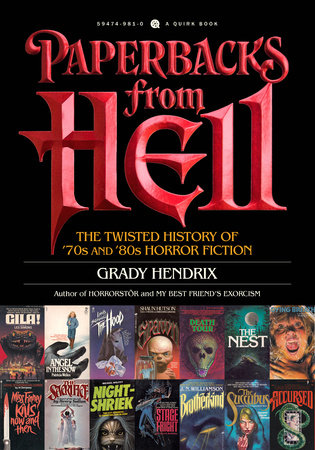 By GRADY HENDRIX (Quirk Books; 2017)
By GRADY HENDRIX (Quirk Books; 2017)
Now here’s a subject I know a bit about: paperback horror novels of the so-called “horror boom” of the 1970s and 80s. Thus I can’t help but cast a highly critical eye on the claims made in this book, an idiosyncratic history of the horror boom by author Grady Hendrix (of the comedic scare novels HORRORSTÖR and MY BEST FRIEND’S EXORCISM). I’ll try not to get too nitpicky in this review, but it won’t be easy!
Overall I enjoyed PAPERBACKS FROM HELL enormously. As a fan of the subject matter I’m obviously a receptive reader, and unless the author really screws things up I can’t fathom not enjoying the book—and the author, thankfully, doesn’t screw things up (much).
Some readers will doubtless criticize the jokey, smart-assed prose, but I say it’s appropriate. I can’t see how one could possibly discuss paperback horror novels without descending into silliness (as attempting to intellectualize most of this stuff won’t get one very far). I find the book’s overall attitude toward its subject matter, articulated in the introduction, quite persuasive: “Divorced from current trends in publishing, these out-of-print paperbacks feel like a breath of fresh air…Though they may be consigned to dusty dollar boxes, these stories are timeless in the way that truly matters: they will not bore you.”
Hendrix provides a more-or-less chronological recounting of the horror boom, from its late 1960s inception to its early 1990s demise. Each chapter covers a different facet of the boom, as exemplified by self-explanatory headings like “Creepy Kids,” “When Animals Attack,” “Real Estate Nightmares” and “Weird Science.”
Innumerable novels are mentioned, ranging from standbys like THE EXORCIST, SALEM’S LOT and FALLING ANGEL to the comparatively obscure, but equally potent, likes of LET’S GO PLAY AT THE ADAMS’ by Mendal Johnson, THE HAPPY MAN by Eric C. Higgs and the novels of the late Ken Greenhall (an interview with Greenhall’s widow fills in quite a bit of background info on this shamefully little-known author). Hendrix even comes up with some intriguing-sounding books with which I wasn’t previously familiar, such as THE VOICE OF THE CLOWN and THE PREDATORS.
For the sociologically minded among you there’s info about the social upheavals that powered the novels under discussion, such as the “white flight” of the seventies (hence the glut of haunted house books that appeared then) and the satanic panic of the eighties (manifested in the gleefully amoral splatterpunk fiction of the era). Also included are profiles of many of the artists who created the unforgettable covers of these novels.
All well and good. But.
I know I said I’ll try and refrain from nitpicking, but I did spot a number of omissions and outright errors. Amongst the latter is a claim that Clive Barker’s BOOKS OF BLOOD was “released in the U.S. in 1986 in the form of six terrible-looking paperbacks” when in fact only three such paperbacks were released, and an assertion that zombies “weren’t doing much in ‘70s and ‘80s horror novels”—well no, not unless you count 80s-era publications like THE BREEZE HORROR by Candace Caponegro, RESURRECTION DREAMS by Richard Laymon, SHE WAITS by Jack Ketchum and IN THE LAND OF THE DEAD by K.W. Jeter. Speaking of omissions, the chapter on serial killer fiction contains an inexplicable absence: BY REASON OF INSANITY by Shane Stevens, which despite having provided the template for Thomas Harris’s RED DRAGON and SILENCE OF THE LAMBS (which are discussed at some length) goes unmentioned.
Also, I think the book concludes a little too abruptly, at the point when “The horror fiction boom of the 1970s and ‘80s became roadkill on the superhighway of the ‘90s.” Outside the Dell Abyss line Hendrix has little to say about ‘90s horror fiction, even though quite a few vital non-Abyss horror novels were published in that period (including THE HOPE by James Lovegrove, THE COUNT OF ELEVEN by Ramsey Campbell, FASTYNGANGE by Tim Wynne-Jones and THE GOLDEN by Lucius Shepard).
I could go on about the books left out of PAPERBACKS FROM HELL but will stop here. After all, to fully do justice to this subject would require a span at least three times that of PAPERBACKS FROM HELL’S 256 page length, and I think most readers will be pleased with what’s here, even if I’m not entirely sated.
